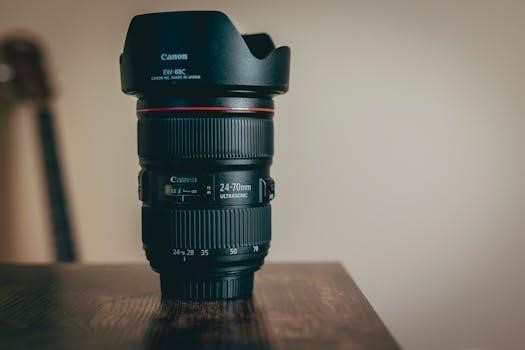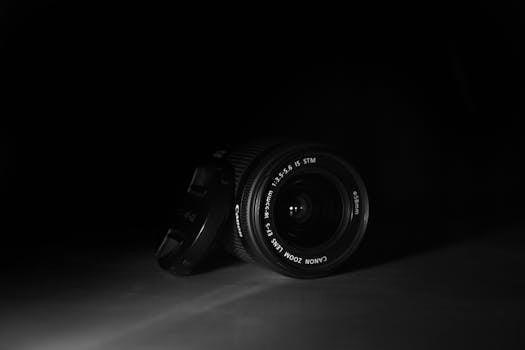Understanding Canon FL Lens Service Manuals
Canon FL lens service manuals are crucial for maintaining and repairing these vintage optics. These manuals provide detailed schematics, parts lists, and step-by-step instructions to facilitate proper repairs. They often include specific procedures for various lens models.
Availability of Official Canon Service Manuals
Finding official Canon service manuals for FL lenses can be challenging, as these lenses are quite old. Canon typically does not distribute these manuals publicly for older product lines. However, some authorized service centers might possess copies. The manuals were primarily intended for internal use by Canon’s repair technicians. Consequently, they are not readily available through regular retail channels. The information within these manuals is highly technical and assumes a certain level of expertise. Therefore, it is important to approach this material with caution. While modern Canon manuals are often digital, older FL manuals would have been printed. This difference impacts how they are accessed today. The lack of direct access creates a need for alternative resources which is why third party guides have become so popular.
Common Issues Addressed in Manuals
Canon FL lens service manuals typically address several common issues that arise with these vintage lenses. These include problems with the aperture mechanism, where blades might become sticky or unresponsive. Focus ring issues, such as stiffness or slippage, are also frequently covered, providing solutions for lubrication or component replacement. Additionally, the manuals detail how to address issues related to the lens’s internal optical elements, such as fungus growth, haze, or dust accumulation, with specific procedures for disassembly and cleaning. Specific repair procedures might cover the replacement of damaged or worn parts, like screws, springs, or other small mechanical components. The manuals often provide detailed diagrams to aid in identifying these parts and their proper placement. These documents are crucial for understanding the complex mechanical and optical makeup of FL lenses, allowing for precise repairs.

Disassembly Procedures for FL Lenses
Disassembly procedures for Canon FL lenses, as outlined in service manuals, are meticulous and require careful attention. These procedures typically begin with the removal of external components like the lens mount and focusing ring, often involving specific screw locations and sequences. Manuals detail the order in which to remove internal components, such as the aperture mechanism and individual lens elements, emphasizing the importance of marking their original orientation. Diagrams and exploded views are crucial for understanding the layered construction of the lens. The manuals emphasize the use of appropriate tools and techniques to avoid damaging delicate parts. Detailed instructions are provided for accessing specific sections of the lens, guiding users through each step to ensure a controlled and safe disassembly process. These procedures are essential for cleaning, repair, or component replacement, and are clearly explained in the service manuals.
Cleaning and Lubrication Guides
Cleaning and lubrication guides in Canon FL lens service manuals are essential for maintaining optimal lens performance. These sections detail specific cleaning agents suitable for lens elements and mechanical parts, cautioning against harsh chemicals that could damage coatings or surfaces. The manuals describe proper techniques for removing dust, fingerprints, and other contaminants, often recommending the use of specialized tools like microfiber cloths and lens brushes. Lubrication instructions are equally important, specifying the correct type of lubricant for different parts of the lens mechanism. These guides outline where and how to apply lubricants, avoiding over-lubrication which can attract dust or cause operational issues. Precise application of lubricants ensures smooth focus and aperture ring movement. Detailed diagrams often accompany these instructions, showing exactly where and how much lubricant to use. These guides are invaluable for anyone looking to maintain their Canon FL lenses.
Specific Component Repair Information
Specific component repair information within Canon FL lens service manuals offers detailed instructions for addressing issues with individual parts. These sections often cover focus rings, aperture mechanisms, and lens element assemblies. Repair guides include exploded diagrams showing how each component fits together, aiding in both disassembly and reassembly processes. For example, the manual might detail how to remove and replace a damaged focus helicoid, along with the specific tools needed. It may also outline procedures for fixing aperture blades that are sticking or misaligned, providing step-by-step instructions and torque specifications for screws. Additionally, these sections often include information on replacing broken lens mount components or other common wear-and-tear parts. These specific repair details are essential for anyone attempting to fix their Canon FL lenses, ensuring that each component is handled correctly and efficiently.
Troubleshooting Common Problems
Canon FL lens service manuals include dedicated sections for troubleshooting common issues that users often encounter. These sections provide diagnostic steps to identify the root cause of problems such as stiff focus rings, unresponsive aperture blades, or hazy internal elements. The manuals will often list symptoms and their corresponding potential causes. For instance, a manual might suggest checking for obstructions in the focus helicoid if the ring is stiff or look for issues with the aperture control linkage if the blades are not moving correctly. These guides usually offer a step-by-step approach, helping users methodically isolate the problem. Also, these sections often include information on diagnosing common problems caused by dirt or grease build-up. They may also address issues related to loose screws or damaged parts, offering specific repair solutions for each case. These troubleshooting sections are invaluable for anyone aiming to perform effective DIY repairs on their Canon FL lenses.

Resources for Finding Canon FL Lens Service Information

Finding reliable service information for Canon FL lenses can be challenging. Online forums, dedicated communities, and third-party repair guides are valuable resources that can aid in locating needed manuals or advice for repairs.
Online Forums and Communities
Online forums and communities dedicated to vintage cameras and lenses are invaluable resources for finding information about Canon FL lens service manuals. These platforms often host discussions where experienced users share their knowledge and experiences with specific lens models. Members may have scanned or digitized service manuals that they are willing to share, or they can provide insights into troubleshooting common issues. Engaging in these communities allows you to ask specific questions, receive personalized guidance, and potentially connect with individuals who have successfully repaired similar lenses. Furthermore, these forums often archive previous threads, creating a searchable database of past discussions that can be incredibly helpful when tackling a repair. Be sure to use the search functionality within forums to look for your specific FL lens model or a specific problem you are encountering. Actively participating by sharing your own progress and findings helps the community grow and become a more valuable resource for everyone.
Third-Party Repair Guides
Beyond official Canon service manuals, third-party repair guides offer alternative resources for working on FL lenses. These guides, often created by enthusiasts or independent repair technicians, can provide unique perspectives and practical tips not found in factory manuals. They may include detailed photographs or videos demonstrating disassembly and reassembly procedures, making complex steps easier to understand. Third-party guides frequently focus on specific repair challenges, addressing common issues that are frequently encountered. Some guides are available as downloadable PDFs, while others may be hosted on websites or video platforms. However, it’s crucial to exercise caution when using these resources and verify the credibility of the source. Compare information across multiple sources when possible, and always prioritize safety when disassembling any lens. Be aware that these guides might not cover every single variation of a specific FL lens, so adaptability is key.

Practical Aspects of Using a Service Manual
Using a Canon FL lens service manual effectively requires careful preparation and adherence to safety guidelines. It’s important to gather necessary tools and understand the limitations of DIY repairs before proceeding. These manuals are a great reference.
Required Tools and Equipment
Successfully utilizing a Canon FL lens service manual for repair necessitates having the correct tools and equipment. Essential items typically include a set of precision screwdrivers, both Phillips and flat-head, in various sizes to accommodate the small screws used in lens assemblies. A lens spanner wrench is often needed for accessing internal components by removing retaining rings. Additionally, having a set of tweezers, ideally with both pointed and rounded tips, is crucial for handling small parts without damaging them. A clean, well-lit workspace is paramount, and a soft, lint-free cloth is necessary for cleaning lens elements. Furthermore, a container to organize and hold removed parts is highly recommended to prevent loss. Depending on the specific repair, specialized tools such as a lens plunger for removing stuck elements, or a caliper for measuring critical distances may also be required. Finally, having the right cleaning solutions and lubricants as detailed in the manual will ensure a successful repair process. It’s important to invest in good quality tools to avoid damaging delicate lens components.
Safety Precautions During Repair
Repairing Canon FL lenses involves working with delicate components and requires strict adherence to safety precautions. Before beginning any repair, ensure you have a clean, well-lit workspace and are free from distractions. Always work methodically and refer to the service manual throughout the process. When disassembling lenses, it’s crucial to be aware of the order and orientation of parts to avoid reassembly errors. Never use excessive force when removing components, as this can easily lead to damage. Be extremely careful when handling lens elements to avoid scratching or fingerprinting them; using gloves or finger cots is highly recommended. When using cleaning solutions or lubricants, ensure proper ventilation to prevent inhalation of fumes. Be mindful of small parts which can be easily lost if not properly organized and stored. If you are unsure about any repair procedure, it’s best to seek professional help to avoid further damage. Always discharge any static electricity before handling electronic components. Finally, remember to take breaks if you are feeling tired to prevent making careless errors. Proper safety habits are essential to protect yourself and the lens.
Limitations of DIY Repairs
While service manuals can be invaluable, it’s crucial to acknowledge the limitations of DIY repairs for Canon FL lenses. Not every repair is suitable for home enthusiasts, even with detailed instructions. Some repairs require specialized tools, such as lens spanners or collimation equipment, which may not be readily available. Furthermore, complex issues like optical element alignment or internal focusing mechanism adjustments often demand a level of expertise that goes beyond a manual’s guidance. Attempting these repairs without proper training could lead to further damage, potentially rendering the lens unusable. Moreover, certain parts might be difficult to source, and incorrect replacements can compromise the lens’s performance and integrity. The risk of accidental damage, such as scratching lens coatings or losing small parts, is also higher for those without extensive experience. Therefore, it is important to assess one’s abilities and the complexity of the repair realistically, and seek professional assistance for tasks that exceed their skills. DIY attempts, while potentially rewarding, can sometimes cause more harm than good.
